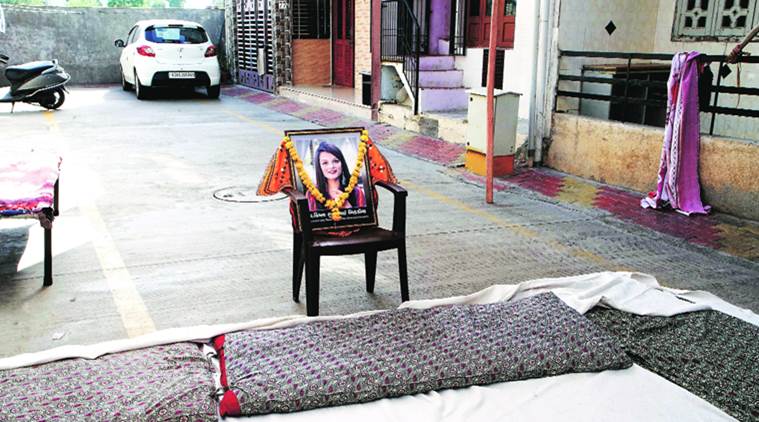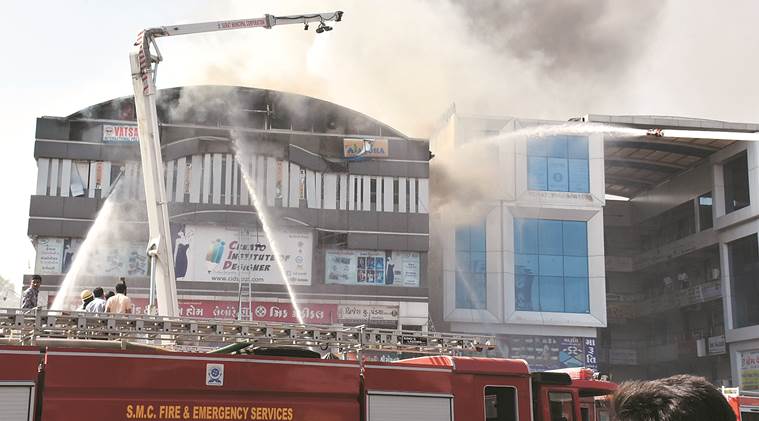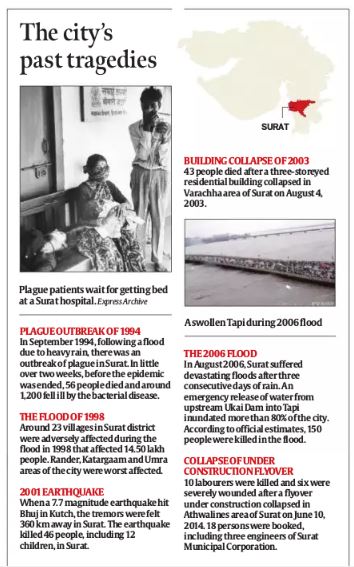- India
- International
Surat Fire: A Summer Tragedy
After the May 24 blaze at a rooftop coaching centre took the lives of 22 youngsters, Surat is grappling with its loss. The Indian Express looks into the city’s past to find answers for its future
 A photograph of 21-year-old Krishna Bhikadiya at her memorial service in Surat last week. She was taking classes of a fashion course on the fateful day when the coaching centre at Takshashila complex (above) caught fire. (Express Photo: Bhupendra Rana)
A photograph of 21-year-old Krishna Bhikadiya at her memorial service in Surat last week. She was taking classes of a fashion course on the fateful day when the coaching centre at Takshashila complex (above) caught fire. (Express Photo: Bhupendra Rana)
In the wee hours of May 25, the Ashwini Kumar ghat on the banks of the Tapi in Surat city had never seen so many mourners since it was built in the aftermath on the deadly plague epidemic of 1994 that had killed 56 people.
Long after the bereaved families and friends of the 22 youngsters killed in the blaze at a coaching centre located on the rooftop of a commercial complex bid their final adieu to their loved ones, the crestfallen city of 4.5 million people is still coming to terms with the unforeseen loss.
“She lived a short life, but a happy one — on her own terms and conditions,” says Dakshaben Kothadia as she tries to smile through her tears, displaying awards won by her 17-year-old daughter Khushali, who jumped to death from the fourth floor of the Takshashila complex in a bid to escape from the fire. Born and brought up in Surat, Khushali had got admitted to a residential school in Rajkot two years ago after completing her class X. However, a year ago, she relocated to Surat to prepare for a career in architecture and got enrolled at a coaching centre in Takshashila complex, located in Varachha area of the city.
Her father, Kiritbahi Kothadia, is the first from his generation who decided to migrate to Surat in 1993 when he was just 15 years old from his village Rangpur in Keshod taluka of Junagadh in search of a better livelihood. His first job was of a labourer at one of the diamond units that dot this city, famous worldwide for its diamond polishing work.
Like Khushali’s father, parents of all the 22 youngsters, who lost their lives in the fire, had migrated to this economically dynamic southern city of Gujarat in search of better livelihood.

 Fire tenders at work at Takshashila complex.
Fire tenders at work at Takshashila complex.
Kantibhai Kakadia, who lost his daughter Isha, had also migrated to the city from an obscure village in Amreli district in early 1980s with his elder brother Ashok who now owns a house in Varachha area of the city, the home to most of the migrants. “We had a small land in our village. But it was mostly dry farming with the lack of adequate water for irrigation. The family was going to expand and we had to look for better opportunities so we moved here. My brother started as a labourer in a diamond factory and now works as a manager in the unit. More than 3,000 people from my village are here in the city and live close by,” says Ashokbhai who now feels more of a Surati, the original residents of Surat.
As per the UNESCO’s report of “Social Inclusion Of Migrants In India”, Surat has the highest number of migrants in the country with 58 per cent of the city’s population comprising people from other parts of Gujarat and country. Touted as the ‘El Dorado’ of Gujarat, Surat has a strong agricultural and agro-processing base combined with heavy investments in industrial sectors such as petrochemicals, textiles, diamond processing, engineering and logistics.
During the 18th and 19 centuries, it was a thriving town in the Gulf of Khambhat, and its ports hoisted flags of 84 nations, literally the entire world. Over the years, beginning with the Dutch, British, Armenians and Mughals established their colonies and set up their trade empires here.

The region still acts like a magnet, drawing in labour — both skilled and unskilled — in large numbers, not only from other parts of Gujarat but also from other parts of the country. Its textile industry is powered by migrants from Rajasthan, Uttar Pradesh, Madhya Pradesh and Bihar.
As per 2011 census, out of Surat’s 44.6 lakh population, the eastern zone the city, Varachha, alone had a population of 11.58 lakh. In this Patidar ghetto, the population has now touched 15 lakh.
The influx of migrants from Saurashtra — the highest from Bhavnagar, followed by Amreli, Junagadh and Jamnagar — started around 1965 and gained momentum in the early 1980s. People, mostly from rural parts of Saurashtra facing water crisis, started working as labourers in textile and diamond units in the city, eventually shifting to other businesses including to real estate, and some even making their way to the top and starting their own businesses. Once an underdeveloped part of the city, Varachha over the years has seen rapid modernisation with construction of flyovers, residential and commercial complexes and BRTS. In view of its vast size and increasing population, the Surat Municipal Corporation had divided the Varachha zone spread across an area of 37 sq km, into two parts for better administration.

The Post-Mortem
Global forecaster, Oxford Economics, in its last year report said that Surat will be the world’s fastest growing city in 2019-35.
Being the eighth largest city of India in terms of population and largest among non-capital cities, Surat is the fourth fastest growing city globally, according to the city mayor’s foundation report. The population of the city, spread over an area of 326.5 square km, has been growing at very fast rate. Between 2001 to 2011, the overall decadal population grew by 55.29 %, with the population in the urban areas growing by 65.52%.
In 2015, Surat was among the 100 cities selected by the Government of India to be developed as a Smart City. Later, the city was ranked fourth in the Smart City Mission.
However, the May 24 tragedy has unravelled the laxity over safety-related issues in the civic body. The Surat Municipal Corporation (SMC), whose annual budget is Rs 5,749.63 crore in 2019-20 — one of the highest in the country — is facing flak for its fire tender not having a ladder tall enough to reach the rooftop of the three-storeyed commercial complex that could have saved the students. The first fire tenders that reached the spot had ladders that could rise to a maximum of 35 metres. With firemen unable to reach the rooftop, many of the students jumped. And those who were afraid to jump died in the blaze. Two days after the fire incident, the SMC got the delivery of a fire engine with a turntable ladder that can reach up to a height of 55 metres.
Notably, in its last Budget (2018-19), the civic body had allotted only Rs 13 crore for fire safety that included the German imported fire engine with turntable ladder, one air compressor machine and a multi-purpose aircore tender.
“Surat has got the tagline of the fastest growing city in the world, but with the boom in all sectors, safety measures are not being taken seriously by the local bodies and individuals,” says BJP MP C R Patil.
Patil, who hails from Jalgaon in neighbouring Maharashtra, made Surat his home in 1955. He won the just concluded Lok Sabha elections from neighbouring Navsari seat with the highest margin in the state.
After presenting a preliminary report on the Surat fire incident to Chief Minister Vijay Rupani, Principal Secretary (Urban Development) Mukesh Puri had also expressed concerns on allowing construction of high-rises, but not having required safety measures in place. “The Surat (fire) episode raises a question. When we are permitting construction of 70-metre-high buildings in some cities, what in case of fire there,” he had asked.
In his recommended remedial steps to pre-empt any such event in future, he has asked the government and civic bodies to prepare a “negative list” of buildings depending on its usage.”All buildings, even those which do not require permission under GDCR, where people’s movement is there or which are vulnerable like schools, colleges, hospitals, nursing homes, cinema halls will be inspected (to check their preparedness for fire). Sometimes, due to low height, a building does not require NOC from Fire (Department).”
Though SMC has suspended three of its officials — Deputy Chief Fire Officer S K Acharya and Fire Officer Kirti Modh, who have been arrested by Surat Crime Branch in connection with the fire tragedy, and Veenu Parmar, a deputy engineer of Town Planning Department — there have been criticisms that the civic body has been shielding itself from the charges of corruption and laxity.
After last November fire incident at a coaching centre killed a student and a teacher, the SMC had carried out survey, in which Takshashila complex was not issued notice despite alleged violations. In a knee-jerk reaction, the SMC officials began a sealing drive of coaching classes and schools. In the statewide drive, 9,962 buildings were surveyed till last week and of them 9,395 were found lacking fire safety features.
The SMC’s order to close all educational institutes till they got a No Objection Certificate (NOC) from its fire department on safety norms was also criticised by many, including MP Patil.
“The fire department should not act immediately. They should have given time to the coaching classes to get NOCs. Education of students gets affected, and who should be held responsible for that? The municipal authorities should have hired out rooms to the coaching classes temporarily, to run the classes till the fire equipment were installed and all the safety measures like safe entry and emergency exits in the coaching classes are made, so that their classes were not affected,” says Patil.
But Municipal Commissioner M. Thennarasan, who is facing the flak, counters it. “We have given time to the tuition centres owners. Those who will not act on instructions, we will seal the buildings,” pointing to the December crackdown when a total 914 properties were surveyed and 440 buildings were asked to comply with fire safety norms, whereas, 39 buildings were sealed. He, however, admitted that the survey missed Takshashila complex.
Lalji Patel, a diamond merchant who had hit the headlines after he bought Prime Minister Narendra Modi’s monogrammed suit for Rs 4.31 crore in 2015, has called for demolition of all “illegal” premises where classes are run. “Abroad, people follow rules and regulations of fire safety. Here, we have fire safety rules and regulations but people and government agencies are not taking it seriously. Flat holders and house owners abroad have to compulsory install fire safety equipment in their houses, and the government officials check it regularly. Similar systems should be in place here,” he says.
The Lessons Learnt
But Surat, which has many firsts to its list — swankiest police station in Umra, an Integrated Command and Control Centre (ICCC) working through a network of 600 CCTV cameras to keep vigil — public-private partnership has been the hallmark of the city.
Textile businessman Ashok Jain, 70, a native of Hisar in Haryana had come to Surat in 1974 to join his brother’s filament yarn business. As a secretary of Traffic Education Trust of Surat, he had played a role in collecting funds for installing the CCTV network.
“The Takshashila fire incident was tragic and pained all of us. However, parents should check and inquire about the safety measures adopted by tuition classes owner, before sending their children. The SMC should spend money to keep its fire department updated with use of latest technology. If fire officials would have got a net, and if it was used at Takshashila incident, lives of many children would have been saved. People should also think of safety on their own by following fire safety norms and not putting the entire responsibility on municipal department officials,” he says.
But Surat, which has been hit by tragedies from flood to earthquake to epidemic, has always rose like a phoenix from the ashes. After the 1994 plague epidemic the then municipal commissioner S R Rao took it upon himself to start a massive cleaning drive and turned around the city. Today, the city has got the tag of the “one of the cleanest cities” in the country. In August 2006, when the city got submerged in its worst flood ever, the civic authorities, having learnt it the hard way, first widened the Tapi river and replaced the old drainage system, and upgraded rainfall measurement systems, to forewarn the residents.
The May 24 tragedy, may also give the city a chance to look inward and rectify its mistakes and lead the country in fire safety norms. At P P Savani School, which lost three of its students, plans are afoot to conduct mock fire safety drills for students and teachers. “Now, we are making extra efforts to carry out drills for students for all possible disaster situations, including fire safety, knowledge about electric appliances and others. Once the school reopens we will immediately begin the drills,” says Harshad Rajguru, Secretary of the Prabudh Education Trust, which runs the school.
At Ashadeep Vidyalaya, which lost five of its students in the fire, dome structures built on the school rooftop have been removed. “The school will now increase the number of mock drills for students to help them face and react in adverse situations. Every year, we conduct mock drills on how to use a fire extinguisher, but now we will concentrate on possible ways of evacuation and how the safety of others can also be ensured,” says Vipul Umretiya, principal of the school.
Apr 16: Latest News
- 01
- 02
- 03
- 04
- 05






































